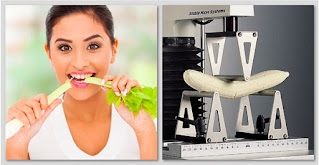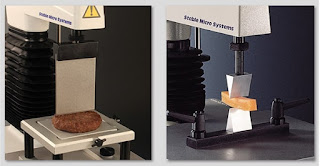
As
opposed to fruits, which are generally picked when mature but unripe,
many vegetables (apart from legume seeds, tubers, bulbs and roots) are
picked and consumed when still immature, tender and succulent.
This
is largely due to the fact that while fruits generally soften on
maturation and storage, young vegetables become tougher when they age.
This toughening is due to the lignification of the primary cell wall and
formation of the secondary cell wall. When cucumbers are stored below
7°C, their texture breaks down due to excessive softening and exudation
of liquid as tissue undergoes a structural collapse. Tomatoes are also
susceptible to low-temperature injury.
Many of the form, structure and physiological considerations discussed in connection with fruit texture also apply to vegetable texture. The main difference is that, while on maturation the fruit tissue stops growing and suffers enzymatic degradation, the vegetable tissue proceeds to differentiate and cell growth and enlargement continue. The amount of fibrous tissue increases. Toughening may reach the point where the vegetable is no longer suitable for human consumption.
A penetration test destructively measures firmness by registering the force required for a Cylinder Probe (generally from 2mm – 8mm in diameter), Magness-Taylor Puncture Probe, or Ball Probe, to penetrate the vegetable’s flesh to a chosen distance and is frequently used for testing firmness of a wide variety of fruits.
Magness-Taylor probes are a widely accepted choice of measuring device when it comes to testing skin strength and flesh firmness of whole fruits and could be used for vegetables such as peppers or aubergines. Being lowered into a sample to the point of piercing its skin or flesh, the penetration test allows flexible and repeatable testing of vegetables.
Dehydration is another cause of textural changes during the storage of fresh vegetables. It can lead to the wilting of leafy vegetables and loss of plumpness in fleshy vegetables. It can be prevented by waxing some vegetables, such as cucumbers and aubergines. Probe penetration tests are well suited to measuring the texture of vegetables with tough skins and fleshy internal tissue. For example, a penetration test into a pepper sample shows a linear force increase as the probe presses into the surface and causes some caving in. The force drops suddenly as the probe penetrates into the skin, which recovers and the probe quickly pushes through the brittle underlying flesh. The force continues to drop gradually as the probe penetrates through the remaining flesh before emerging through the other side. All of these graph properties can be assessed separately during analysis for a full picture of the pepper’s texture.
The beauty of a penetration test such as this is that sample preparation is minimum and sample size does not need to be controlled. Care should be taken however to consider orientation of the penetration test as samples of this nature are anisotopic so you must try to choose the same test region between vegetables for comparison purposes. Roots and Tubers such as carrots, parsnips, potato, yams, are homogeneous large and starchy roots with predominantly uniform structures. However, taproots may incorporate central woody cores which will influence the texture results and sample isotropy. If the sample is presented to the Texture Analyser in different directions different results will be obtained. The depth of penetration varies according to the vegetable size and proximity to e.g. pits, cores and it is sometimes possible to perform tests on both sides of each vegetable tested e.g. aubergine.
Fibre formation is a particularly important problem with asparagus. Asparagus fibrousness can be measured using a cutting test with a wire or blade. The Warner Bratzler Blade is ideal for round samples due to its v-shaped notch, and it can be used along with a slotted insert to guide the blade into a Heavy Duty Platform for total shearing of an asparagus spear. The further the fibrous tissue has developed, the higher this shearing force will be.
Rigidness of long vegetables such as celery or freshly prepared batons will be compromised during storage and will become more flexible as freshness reduces. A means to measure this loss of turgidity is via a Three Point Bend test where the sample is supported by two lower beams and force is applied centrally up to the point of break. The distance (and force) at the break point will be a clear measure of whether the sample is rigid and crisp or soft and flexible.
In general, lowering the temperature at which fresh vegetables are stored will decrease their rate of textural changes by slowing down the metabolic processes. However, exceptions are potatoes, cucumbers and tomatoes. White potatoes, which contain a lot of starch at harvest, will undergo a starch to sugar conversion when stored below 10°C. This conversion leads to textural deterioration in both raw and cooked potatoes, a sweet taste, and a proneness to browning on dehydration, which can cause problems in the manufacture of potato chips. The texture of both raw and cooked potato can be measured using a Knife Blade test. Samples are cut to constant known dimensions for high repeatability and sheared. Maximum force is seen to decrease substantially as the length of cooking time is increased.
Using this method requires that samples have the same dimensions for comparison purposes. A Twin Blade Sample Preparation Tool or Core Borer are suitable tools for this.
An alternative shearing method is where a controlled dimension baton of sample is mounted between two Fracture Wedges and the sample is sheared from both upper and lower directions.
There is a Texture Analysis test for virtually any physical property. Contact Stable Micro Systems today to learn more about our full range of solutions.
For more information on how to measure texture, please visit the Texture Analysis Properties section on our website.
 The TA.XTplus texture analyser is part of a family of texture analysis instruments
and equipment from Stable Micro Systems. An extensive portfolio of
specialist attachments is available to measure and analyse the textural properties of a huge range of food products. Our technical experts can also custom design instrument fixtures according to individual specifications.
The TA.XTplus texture analyser is part of a family of texture analysis instruments
and equipment from Stable Micro Systems. An extensive portfolio of
specialist attachments is available to measure and analyse the textural properties of a huge range of food products. Our technical experts can also custom design instrument fixtures according to individual specifications.
No-one understands texture analysis like we do!
To discuss your specific test requirements click here...
For more information on how to measure texture, please visit the Texture Analysis Properties section on our website.
 The TA.XTplus texture analyser is part of a family of texture analysis instruments
and equipment from Stable Micro Systems. An extensive portfolio of
specialist attachments is available to measure and analyse the textural properties of a huge range of food products. Our technical experts can also custom design instrument fixtures according to individual specifications.
The TA.XTplus texture analyser is part of a family of texture analysis instruments
and equipment from Stable Micro Systems. An extensive portfolio of
specialist attachments is available to measure and analyse the textural properties of a huge range of food products. Our technical experts can also custom design instrument fixtures according to individual specifications.No-one understands texture analysis like we do!
To discuss your specific test requirements click here...









No comments:
Post a Comment